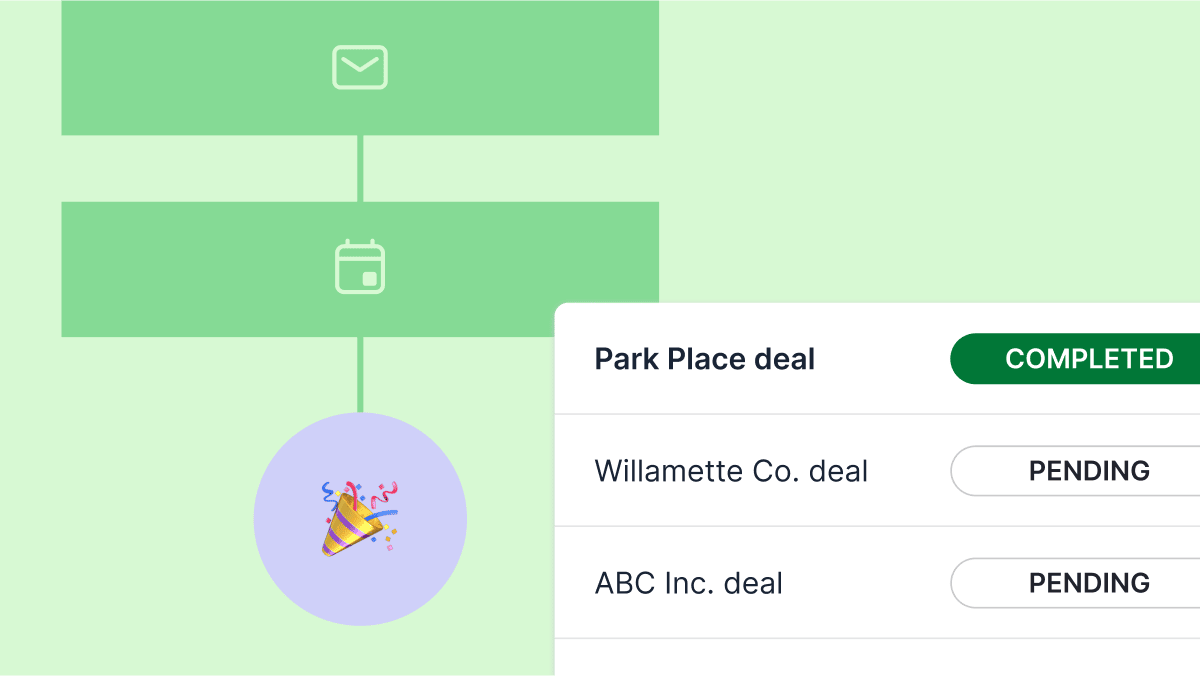Sales are the lifeblood of any business, and a well-crafted sales guide can be the secret weapon for success. It can significantly improve your sales strategy and help you achieve better results.
Whether you’re new to the game or a seasoned professional, this guide delivers essential tips and techniques for every stage of the sales funnel, from prospecting to closing. It helps sales reps understand and master what is needed for success and offers advanced techniques to set them apart from the competition.
Implementing these proven strategies will help you build stronger relationships with your clients, easily handle objections and close deals more effectively, ultimately driving business growth and increasing revenue.
What is a sales guide?
A sales guide is a comprehensive resource designed to help sales teams navigate the complexities of the sales process. These guides provide structured strategies, best practices and actionable steps to enhance sales performance and customer engagement.
These are essential tools for any sales team, offering clear direction and support throughout the sales journey. They often cover various topics, including prospecting, customer relationship management, negotiation techniques and closing strategies.
A sales guide can be compared to a comprehensive playbook that equips salespeople with the strategies, talking points and approaches to navigate customer interactions confidently. More than just documents, they serve as roadmaps for winning deals with precision and consistency.
Understanding the sales process guide: 6 steps for successful sales
Understanding the sales cycle is fundamental to achieving consistent success in sales. It begins with identifying potential customers and assessing their suitability for your product. Then, you present your offering, address any concerns and work toward securing the sale.
Ensuring customer satisfaction through follow-up is a must when building long-term relationships. Mastering each stage of this process maximizes your sales efforts, strengthens client relationships and drives better sales outcomes. Focusing on these six key aspects can enhance your sales strategy and help you achieve greater success.
Prospecting: Identify potential customers interested in your product or service. Use social media, email marketing and networking events to find prospects.
Qualification: Determine if the prospect fits your offering well. Ask questions to understand their needs, budget and decision-making process to avoid wasting time on leads that are unlikely to convert.
Presentation: Showcase the benefits of your product or service. Tailor your sales presentation to address the prospect’s specific pain points. Make it clear how your offering can solve their problems and improve their day-to-day.
Objections: Handle sales objections after presenting. Listen to the prospect’s concerns and provide clear, concise answers to alleviate their doubts, build trust and move the conversation closer to a sale.
Closing: Ask for the sale with confidence. Use different closing techniques, such as the assumptive close, the urgency close or the option close. Choose the one that best suits your style and the prospect’s situation.
Follow-up: Keep in touch after the sale to guarantee customer satisfaction and encourage repeat business or referrals. A good follow-up can turn a one-time buyer into a loyal customer. According to Frederick Reichheld of Bain & Company, increasing customer retention rates by 5% increases profits by more than 25%.
Essential sales techniques
When sales techniques are executed well, they promote smoother interactions and more persuasive communications, making it easier to guide prospects through the buying journey.
Doing so increases the chances of closing deals and enhances customer loyalty and satisfaction, leading to repeat business and referrals.
Mastering these techniques allows salespeople to differentiate themselves from competitors, showcasing their expertise and professionalism – significantly impacting overall sales performance and long-term success.
| Active listening | Pay close attention to what the prospect is saying. Doing so helps you understand their needs and tailor your pitch accordingly. It also demonstrates that you value their input and are committed to finding the best solution for them |
| Building rapport | Establish a connection with your prospect by finding common ground and showing genuine interest in their business. People are more likely to buy from someone they trust and feel comfortable with. Building rapport fosters a positive relationship that can lead to long-term customer loyalty and repeat business. |
| Value selling | Focus on your product or service’s value rather than just its features. Explain how it solves the prospect’s problems and makes their life easier or business more successful. Highlighting the benefits helps prospects see the tangible impact of your offering, making it more compelling and relevant to their needs. |
| Storytelling | Storytelling can make your pitch more engaging and memorable. Share stories illustrating how your offering has helped other clients, making your benefits more tangible and relatable. Such techniques help prospects visualize the positive outcomes they can achieve with your product or service. |
| Social proof | Incorporating social proof builds credibility and trust. Share testimonials and customer stories to show that others have had positive experiences with your product or service. Doing so reassures prospects that they make a reliable and beneficial choice by picking your offering. |
Maximizing efficiency with the best sales tools
Modern sales tools can streamline your workflow and boost efficiency. Customer relationship management (CRM) systems like Pipedrive help track interactions with prospective customers, manage sales pipelines and analyze data to enhance your strategy.
Pipedrive offers features like visual sales pipelines, activity reminders and performance insights, enabling sales teams to stay organized and focused on closing deals. No lead is overlooked, sales activities are optimized and sales outcomes are improved.
Email automation tools like Mailchimp and Campaigns allow you to schedule and send personalized emails at scale, saving time and maintaining consistent communication with prospects. According to research, 72% of successful companies use marketing automation, compared to 18% of unsuccessful companies.
Sales enablement platforms provide your team with essential resources, training and content to close more deals, significantly improving effectiveness. Additionally, analytics and reporting tools such as Google Analytics and Microsoft Power BI help monitor sales performance and identify areas for improvement. Analyzing this invaluable data lets you make informed decisions and refine your sales strategies.
Creating a winning sales pitch
A compelling sales pitch can make or break your business’s success. Start by researching your audience. Understand their needs, preferences and pain points, then tailor your pitch to address these aspects. Doing so can improve the overall customer experience and make your pitch more relevant.
When structuring your pitch, begin with a strong opening that immediately grabs attention. Present the problem and explain how your product or service solves it. Highlight key benefits and differentiators and end with a clear call to action inviting the prospect to take the next step.
Practice your pitch multiple times. Rehearse in front of colleagues or mentors and ask for feedback, making the necessary adjustments to ensure your pitch is polished and persuasive.
Building a high-performance sales team
Creating a high-performance sales culture is essential if you’re leading a sales team. Here’s how to build and maintain a successful sales team:
Recruit top talent. Look for candidates with the right skills and attitude. Use assessments and interviews to gauge their fit. Hire individuals who are not only capable but also align with your company’s values and culture.
Offer training and development opportunities. Provide training and development opportunities for your team. Sales techniques and tools constantly evolve, so keeping your team updated is crucial. Offer regular training sessions and workshops and provide access to relevant resources.
Set clear goals. Define specific, measurable, achievable, relevant and time-bound (SMART) sales targets. Make sure each team member understands their role in achieving these goals and how their performance will be measured.
Incentivize. Motivation is key in sales. Use incentives like bonuses, awards and recognition to keep your team motivated. Acknowledge their hard work and celebrate their successes, both big and small.
Measure performance. Monitoring performance is vital for tracking your team’s success. Survey key metrics like conversion rates, average deal size and sales cycle length. Use this data to identify areas for improvement and make informed decisions about your sales strategy.
Sales managers can significantly improve their team’s performance by turning prospects into customers through strategic guidance and support.
Future trends in sales
Staying ahead of trends is essential for long-term success. Here are some emerging trends to keep an eye on:
Artificial intelligence (AI). AI can automate repetitive tasks, provide insights through predictive analytics and improve lead scoring – allowing sales teams to focus on higher-value activities and close deals more efficiently.
Virtual and augmented reality (VR/AR). VR/AR can enhance product demonstrations and create immersive experiences for prospects. VR/AR technology can be particularly useful for complex or high-value sales, where seeing the product in action can make a significant difference. Research by Gartner suggested that 70% of enterprises were expected to experiment with immersive technologies for customer and employee interactions.
Personalization. Today’s buyers expect personalized experiences. Use data to tailor your approach to each prospect, from customized email campaigns to personalized sales pitches.
Social selling. Use social media platforms to connect with prospects, share valuable content and build relationships. As social media continues to play a significant role in buyers’ lives, leveraging these platforms for sales will become increasingly important.
Pipedrive stays ahead of future sales trends by integrating cutting-edge technologies like Pipedrive AI, leveraging artificial intelligence and machine learning. These features provide predictive analytics and actionable insights, helping sales teams anticipate customer needs and optimize strategies, ensuring adaptability to evolving market conditions.
Final thoughts
Mastering sales requires understanding the sales process, utilizing effective techniques, leveraging modern tools and continuously refining your customer-centric approach.
Whether you’re a beginner or an experienced sales rep, a sales guide provides the knowledge and strategies needed to succeed. Stay motivated, keep learning and adapt to changing trends to consistently achieve your sales goals.
Pipedrive is an invaluable tool for sales teams embarking on this journey. Its flexibility and robust integration capabilities allow businesses to customize the platform to their specific needs. Flexibility, combined with easy connections to widely used tools, helps Pipedrive users effectively manage and excel in the ever-changing sales environment.







